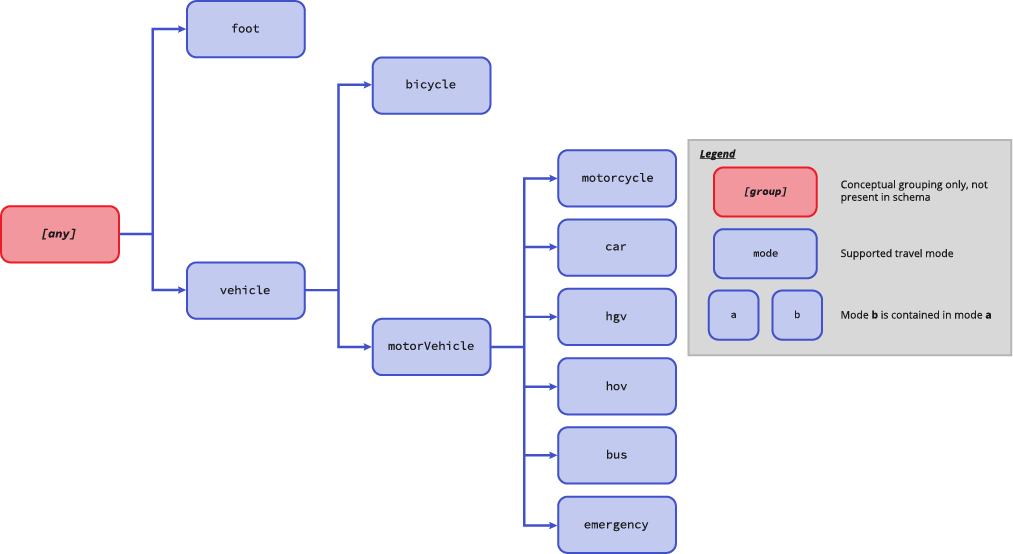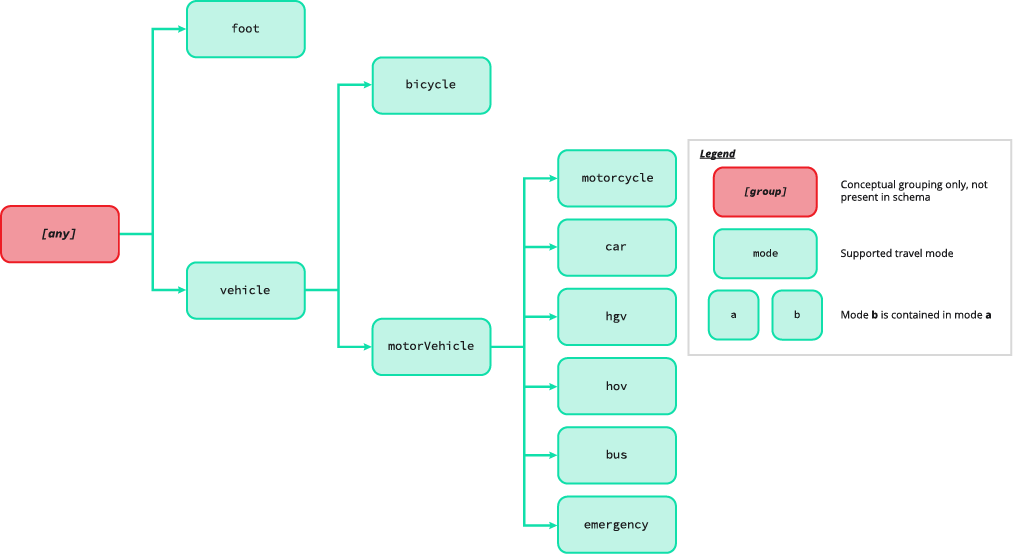Travel modes
In the real world, a travel mode can be thought of intuitively as a way of getting from point A to point B. Travel modes can include non-vehicle modes (foot), vehicle modes (a bicycle or motor vehicle) and occasionally more granular details (that motor vehicle might be classified as a high occupancy vehicle or a heavy goods vehicle).
Within the Overture Maps transportation theme schema model, this real-world intuition translates to the following definition: a travel mode is a recognized mode by which a person or thing may use a segment feature.
Understanding travel modes
Implied travel modes
Every segment has an implied set of travel modes that are allowed to use the segment. For road segments, this implied set derives from the road class, as well as local rules, norms, and customs operative where the road segment is situated.
Since this implied set depends on locality or jurisdiction, and is susceptible of varying over time, the Overture Maps transportation schema does not try to specify the implied set. Resolution of the implied set is done by the specific application in the case where this level of detail is important for its proper functioning. Note: an accurate routing engine may need this information, whereas a 2D map render or a geocoder likely do not.
General definitions
Overture's recognized travel modes are defined in general terms that are
broadly applicable, for example hov is a high-occupancy vehicle and
hgv is a heavy goods vehicle. In most jurisdictions, these general
terms map to a concept that is in use within the jurisdiction, even
though the local name for the concept may vary, for example one
jurisdiction may say heavy goods vehicle and another may say
large goods vehicle.
Despite being broadly applicable, travel modes may have different definitions in different places and at different times.
- in one jurisdiction, an
hgvmight mean any vehicle with a gross vehicle weight in excess of 3.5 tonnes (3,500 kg). In another place, anhgvmight have a gross vehicle weight of at least 10,001 lbs. - in one jurisdiction, an
hovmight require a minimum of 2 passengers while in another place it might have a higher minimum passenger count, or include battery-electric vehicles, or exclude certain classes of vehicle or usage.
As a consequence of the variance in definition across place and time, Overture gives only general definitions for travel modes, leaving precise definition to those applications that require them.
When is a travel mode recognized?
A travel mode is recognized by the Overture transportation schema when
it becomes part of the mode
enumeration. This enumeration in early versions of the schema was relatively small and contained only travel modes that are generally-applicable both across jurisdictions and over time. As development of the schema has progressed, this list has grown and will to continue to expand as the world changes and new information arises.
Our criteria for recognizing a proposed new travel mode are:
- the proposed new travel mode should represent a generally-accepted concept meaning that the concept exists in many places with roughly the same definition.
- the proposed new travel mode should be referred to with well-known sign iconography or sign text in those jurisdictions where the concept exists; and this iconography or sign text is preferably somewhat consistent across many jurisdictions and over time.
- it must be possible to give a relatively precise definition to the proposed new travel mode and explain how it differs from, or intersects with, other similar travel modes which are already recognized in the Overture schema.
- the proposed new travel mode should preferably not be trivially
expressible using another existing scoping property.(An example of such a trivially-expressible concept might be a three-axle vehicle which is more appropriately phrased as
vehicle: { axle_count: { is_equal_to: 3 } }.) - the proposed new travel mode must be supported by existing data in at least one of Overture's upstream data sources.
There is a risk that the above-described approach will be too slow to adapt to our users' needs in a vast, ever-changing world. One possible avenue to mitigate this risk is supporting custom extensions to the built-in list of recognized travel modes.
Travel mode schema
Scoping to travel modes
Travel modes can be used to change the scope of scoped and rule-based properties within the schema. For example, they can affect the scope of access restrictions, turn restrictions, or speed limits on road segments. Since travel modes are expressed via scoping properties, we recommend you read the section on scoped and rule-based properties before proceeding further.
Travel mode scoping: mode
The scoping property mode controls whether a given scoped property
applies when a given travel mode is being used for traveling along a
road segment.
If mode is provided, it must be a non-empty array of string values
identifying travel modes, and is interpreted as a set. Values must be
unique, but order is not important.
Vehicle attribute scoping: vehicle
Because travel modes are an fuzzy concept, there are inevitably areas
of overlap between with the more precise, but more limited, vehicle
scoping property which is used for vehicle attributes scoping. Where there is potential overlap, the method of scoping used in Overture Maps data releases will depend on how the upstream data source has expressed the equivalent concept. Where there is choice, it is preferable to select the scoping method that most accurately reflects the intention expressed on local signage.
Similar scoping properties: using and recognized
The scoping properties using and recognized express concepts that
are meant to be orthogonal to (completely separate from) travel modes.
- The
usingproperty indicates purpose of use scoping, which relates to the purpose for which the person or thing travelling is using a given segment of the transportation network. Travel modes should ideally not embed a purpose of use. - The
recognizedproperty indicates status scoping, which relates to a recognized status given to the person or thing traveling, where the recognized status is distinct from the mode of travel itself. Travel modes should ideally not embed a status.
The travel modes taxonomy
Travel modes in Overture Maps form a shallow taxonomy. Some travel modes are
more general, while others are more specific, and a more general travel
mode may contain a more specific one. For example, the general travel
mode vehicle contains the more specific mode motor_vehicle. The
taxonomy supported in our draft schema v0.8.0 can be visualized in the
diagram below.


The Overture travel modes taxonomy.
As many of the above travel modes draw on the body of knowledge accumulated in relation to OpenStreetMap transport mode access restrictions, Overture Maps would like acknowledge a intellectual debt to the OSM community in relation to travel modes as well as to other aspects of the transportation schema.
Open questions
This section discusses some open questions we are debating internally with regard to travel modes. We would love to hear your feedback on these questions and any others you may have.
Minimum required travel modes
We're not yet certain on the minimum set of recognized travel modes is that will make the Overture Transportation schema as usable as possible to as broad an audience as possible. What do you think we are missing?
Should we support extension travel modes?
We live in a time of rapid technological and regulatory change in the transportation space. No matter how quickly we extend the travel modes in the Overture Maps schema it will always be behind the real world with regard to some technologies, customs, or local rules.
One way to support users working at the cutting edge is to allow custom extensions to
the list of travel modes. If we did this consistently with how extension
properties
work for features, we could, for example, allow travel mode names with
the ext_* to be ignored by the schema validation rules.
Internal consistency
In another section of this documentation, we alluded to an overlap between the fuzzy concept of travel modes and vehicle attribute scoping. We're aware of this overlap and view it as limited but inevitable.
Our intention is to reduce or eliminate the overlap between travel modes and the other similar scoping properties
(using and recognized). One area where we may have been unsuccessful
is the emergency travel mode in the current taxonomy.
Arguably, emergency should be removed from the taxonomy, and an
as_emergency_responder should be included in the status values enumeration for the recognized property.